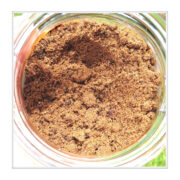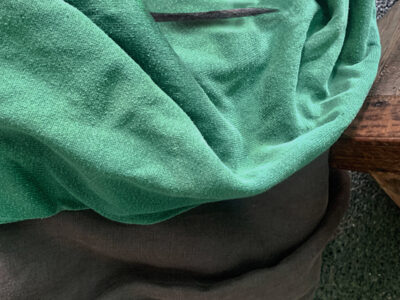Allergen
Acrylates
Named 2012’s Contact Allergen of the Year by the American Contact Dermatitis Society, acrylates are interesting because, a little like clay and ceramics, they are strong irritants and allergens when wet (or in their powder or paste form) but tend to be fine when hardened.
Polymerization is the process that causes acrylates to harden. When polymerized, acrylates are less of a problem (they are non-reactive or inert). If you have patch-tested positive to acrylates, it is very important to avoid them when in their pre-polymerized (monomer) state as liquids, powders (which can be airborne), or pastes. When hardened, however, you might be able to tolerate some contact with them as most are not irritating or allergenic. For example:
- Handling inks or glues in printing (where the acrylates might be wet or airborne) would be discouraged but touching a printed page in a book (where the print and adhesives are already well dried) might be fine.
- Wearing false eyelashes might not work because the glue has to be applied directly onto the skin while it is wet, which is when it is most reactive. Artificial nails might not be advisable for the same reason: the glue is applied wet and close enough to the nail bed to risk a contact reaction. Medical sprays and some dental materials would also tend to be a problem as they are applied onto the skin in a pliable form and left to harden.
- But a mascara with acrylates that is applied wet onto lashes (not onto the skin directly) and then dries very quickly in a few seconds might be ok … especially if it is a non-smearing formulation so that any contact with the skin is only when the acrylates are fully dried.
- Being involved in the manufacture of certain plastic bottles might not be advisable but drinking sodas from the same bottles (long after they are manufactured) may not cause any problem.
- Painting might not be the hobby for you but occasionally touching a painting after it has completely dried (and certainly admiring it on your wall) should be fine.
If you work in a job that requires handling or working around acrylates in their monomer form, consider a barrier like a white or unbleached pair of gloves under nitrile gloves (methyl methacrylate can cross through latex and vinyl gloves).
If you have a history of sensitive skin…
…don’t guess! Random trial and error can cause more damage. Ask your dermatologist about a patch test.
To shop our selection of hypoallergenic products, visit vmvhypoallergenics.com. Need help? Ask us in the comments section below, or for more privacy (such as when asking us to customize recommendations for you based on your patch test results) contact us by email, or drop us a private message on Facebook.
For more:
- On the prevalence of skin allergies, see Skin Allergies Are More Common Than Ever.
- For the difference between irritant and allergic reactions, see It’s Complicated: Allergic Versus Irritant Reaction.
- For the difference between food, skin, and other types of reactions: see Skin & Food Allergies Are Not The Same Thing.
- To learn about the VH-Rating System and hypoallergenicity: What Is The Validated Hypoallergenic Rating System?
Main References:
Regularly published reports on the most common allergens by the North American Contact Dermatitis Group and European Surveillance System on Contact Allergies (based on over 28,000 patch test results, combined), plus other studies. Remember, we are all individuals — just because an ingredient is not on the most common allergen lists does not mean you cannot be sensitive to it, or that it will not become an allergen. These references, being based on so many patch test results, are a good basis but it is always best to get a patch test yourself.
1. Warshaw, E.M., Maibach, H.I., Taylor, J.S., et al. North American contact dermatitis group patch test results: 2011-2012. Dermatitis. 2015; 26: 49-59.
2. W Uter et al. The European Baseline Series in 10 European Countries, 2005/2006–Results of the European Surveillance System on Contact Allergies (ESSCA). Contact Dermatitis 61 (1), 31-38.7 2009.
3. Wetter, DA et al. Results of patch testing to personal care product allergens in a standard series and a supplemental cosmetic series: An analysis of 945 patients from the Mayo Clinic Contact Dermatitis Group, 2000-2007. J Am Acad Dermatol. 2010 Nov;63(5):789-98.
4. Verallo-Rowell VM. The validated hypoallergenic cosmetics rating system: its 30-year evolution and effect on the prevalence of cosmetic reactions. Dermatitis 2011 Apr; 22(2):80-97.
5. Ruby Pawankar et al. World Health Organization. White Book on Allergy 2011-2012 Executive Summary.
6. Misery L et al. Sensitive skin in the American population: prevalence, clinical data, and role of the dermatologist. Int J Dermatol. 2011 Aug;50(8):961-7.
7. Warshaw EM1, Maibach HI, Taylor JS, Sasseville D, DeKoven JG, Zirwas MJ, Fransway AF, Mathias CG, Zug KA, DeLeo VA, Fowler JF Jr, Marks JG, Pratt MD, Storrs FJ, Belsito DV. North American contact dermatitis group patch test results: 2011-2012.Dermatitis. 2015 Jan-Feb;26(1):49-59.
8. Warshaw, E et al. Allergic patch test reactions associated with cosmetics: Retrospective analysis of cross-sectional data from the North American Contact Dermatitis Group, 2001-2004. J AmAcadDermatol 2009;60:23-38.
9. Foliaki S et al. Antibiotic use in infancy and symptoms of asthma, rhinoconjunctivitis, and eczema in children 6 and 7 years old: International Study of Asthma and Allergies in Childhood Phase III. J Allergy Clin Immunol. 2009 Nov;124(5):982-9.
10. Kei EF et al. Role of the gut microbiota in defining human health. Expert Rev Anti Infect Ther. 2010 Apr; 8(4): 435–454.
11. Thavagnanam S et al. A meta-analysis of the association between Caesarean section and childhood asthma. Clin Exp Allergy. 2008;38(4):629–633.
12. Marks JG, Belsito DV, DeLeo VA, et al. North American Contact Dermatitis Group patch-test results, 1998 to 2000. Am J Contact Dermat. 2003;14(2):59-62.
13. Warshaw EM, Belsito DV, Taylor JS, et al. North American Contact Dermatitis Group patch test results: 2009 to 2010. Dermatitis. 2013;24(2):50-99.
14. Verallo-Rowell V. M, Katalbas S.S. & Pangasinan J. P. Natural (Mineral, Vegetable, Coconut, Essential) Oils and Contact Dermatitis. Curr Allergy Asthma Rep 16,51 (2016) . https://doi.org/10.1007/s11882-016-0630-9.
15. Park G, Oh DS, Lee MG, Lee CE, Kim YU. 6-Shogaol, an active compound of ginger, alleviates allergic dermatitis-like skin lesions via cytokine inhibition by activating the Nrf2 pathway. Toxicol Appl Pharmacol. 2016 Nov 1;310:51-59. doi: 10.1016/j.taap.2016.08.019. Epub 2016 Aug 22. PMID: 27562088.
16. de Groot AC. Monographs in Contact Allergy, Volume II – Fragrances and Essential Oils. Boca Raton, FL: CRC Press Taylor & Francis Group; 2019.
17. De Groot AC. Monographs in Contact Allergy Volume I. Non-Fragrance Allergens in Cosmetics (Part I and Part 2). Boca Raton, Fl, USA: CRC Press Taylor and Francis Group, 2018.
Want more great information on contact dermatitis? Check out the American Contact Dermatitis Society, Dermnet New Zealand, the Contact Dermatitis Institute, and your country’s contact dermatitis association.
Laura is our “dew”-good CEO at VMV Hypoallergenics and eldest daughter of VMV’s founding dermatologist-dermatopathologist. She has two children, Madison and Gavin, and works at VMV with her sister CC and husband Juan Pablo (Madison and Gavin frequently volunteer their “usage testing” services). In addition to saving the world’s skin, Laura is passionate about health, inclusion, cultural theory, human rights, happiness, and spreading (like a VMV cream!) goodness!





[…] Items with shine as that could suggest a resin or other finish with acrylates. […]